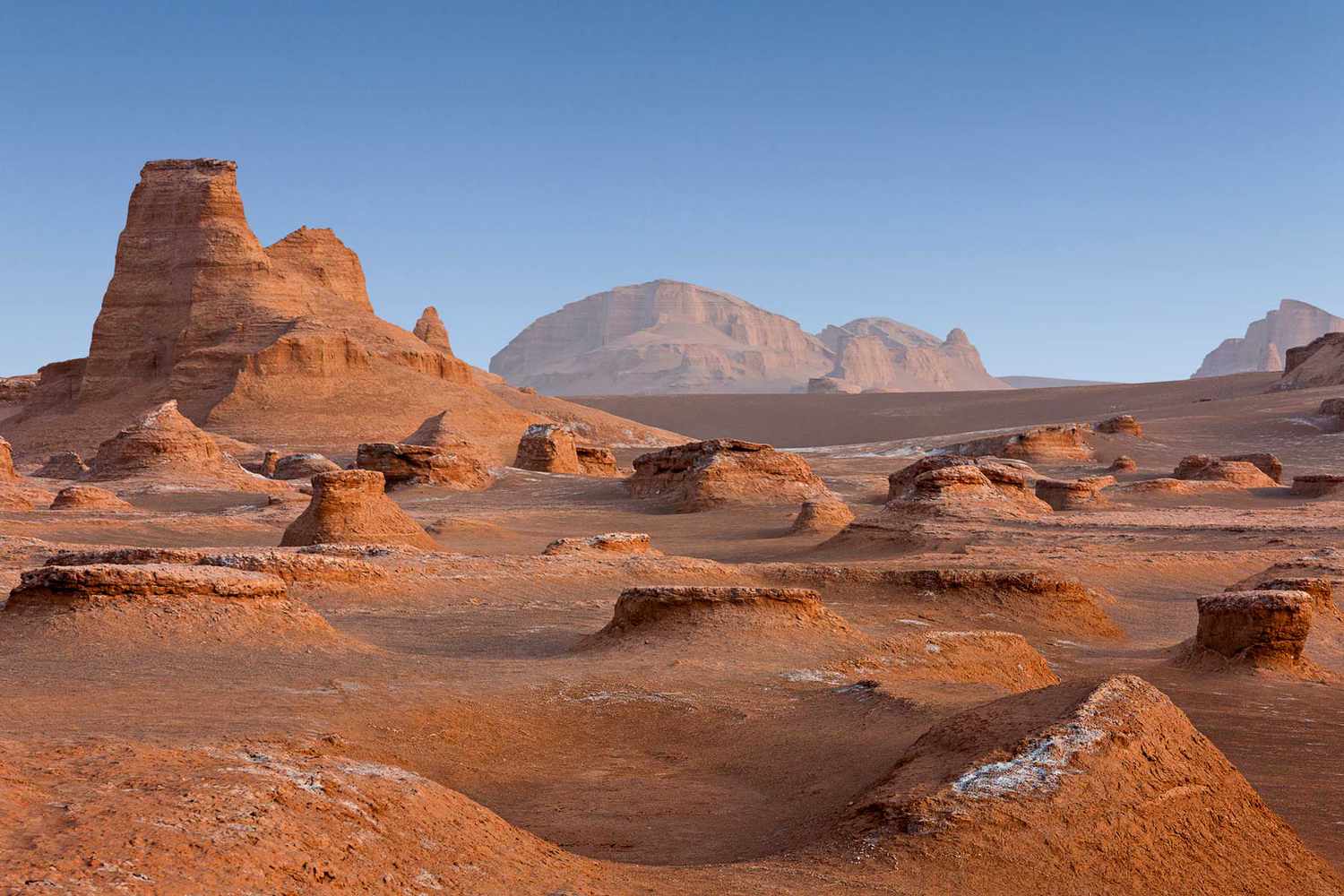When you dream of jetting off to somewhere warm and sunny, you likely picture a beach with temperatures in the 80s or maybe 90s—not a desert that gets up to 130 degrees. But for those with extremely hot destinations on their must-visit lists, these steamy cities and barren stretches of baking dirt are of particular interest. They’re the hottest places on Earth.
Death Valley in California is well known to be the world’s hottest place, but some of the other locations might surprise you, like a city in Patagonia and a very touristy part of Greece. Some are known for year-round heat, while others can be relatively pleasant throughout the cooler months before reaching summertime extremes. Plan to visit—or avoid—these sweltering spots from the U.S. to Australia.
Death Valley, California
Rory Fuller / Travel + Leisure
According to the World Weather and Climate Extremes Archive of the World Meteorological Organization (WMO), temperatures in Death Valley reached 134 degrees Fahrenheit in 1913—the hottest air temperature recorded anywhere in the world. Although some scientists debate the reliability of historic temperature readings, Death Valley reportedly hit 130 degrees again in 2020 and 2021. It’s all about the terrain in this part of the Mojave Desert that makes it so sweltering; the lofty peaks of the surrounding Sierras trap heat inside this low-elevation valley (below sea level), and there’s very little vegetation to block the heat from penetrating the ground. The average summer day in Death Valley National Park reaches about 100, though it isn’t uncommon for temperatures to soar above 120. The weather is much more tolerable for travelers in the winter.
Kebili, Tunisia
Kebili, Tunisia, holds the record for the highest temperature ever recorded in the Eastern Hemisphere. The WMO’s weather archive notes that it reached 131 degrees Fahrenheit in July 1931. Kebili is a historic oasis in the vast and arid Sahara Desert of North Africa. Tourists visit to see the stark sandy landscape and feel the less-intense warmth in the spring and summer. June through September is an unadvisable time to make a trip unless you like daily highs well over 90 degrees.
Mitribah, Kuwait
Shahbaz Hussain’s Photos/Getty Images
Mitribah is not a town but a weather station in the remote Kuwait Desert about 20 miles from the Iraq border. It recorded the highest temperature in the WMO’s Region II, which encompasses most of Asia, in July 2016, when it reached 129 degrees. In addition to the heat it experiences just from being near the equator, Mitribah also catches the shamal winds that carry hot, dry air across the Middle East. Daily highs in the summer tend to exceed 100 degrees.
Tirat Tsvi, Israel
DEA/ARCHIVIO J. LANGE/Getty Images
Tirat Tsvi—also spelled Tirat Zvi—is a kibbutz (a communal settlement) in the Beit She’an Valley of northeast Israel, near the border of Jordan. With the highest documented temperature being 129 degrees in June 1942, this place holds the record in WMO’s Region VI, which includes Europe, the Middle East, and Greenland. Thankfully, there are swimming holes to help the locals cool off. The name of the valley actually translates to “Valley of the Springs,” and even though it’s forbidden to swim on the Sabbath, the rabbi has made an exception for children in this steaming hot community.
Turbat, Pakistan
In May 2017, Turbat, Pakistan, experienced blistering heat exceeding 128 degrees, one of the hottest temperatures ever recorded in Asia. Turbat is a city in the very arid Balochistān province on the banks of the Kech River. Heat waves are common here and throughout Pakistan, but they’re even more frequent in recent years because of climate change. In 2024, the country experienced a prolonged heat wave that killed more than 500 people, primarily in Sindh, east of Turbat.
Oodnadatta, Australia
Oodnadatta is located about halfway between Adelaide and Alice Springs near the blistering hot center of Australia. It’s where the highest temperature in the Southern Hemisphere (123 degrees) was recorded in January of 1960. Despite how hot it gets in this Outback town, and that it’s two and a half hours off the main road that cuts through the Red Centre, tourists still go out of their way to visit—mainly to take on the Oodnadatta Track, a 382-mile drive that follows a historic Aboriginal trading route. Of course, if you’re adventurous to attempt it, plan your trip for winter.
Rivadavia, Argentina
Paulo Hoeper/Getty Images
The highest temperature ever recorded in South America was outside of the city of Rivadavia in the Salta Province of northwestern Argentina. The landscape in this region is a diverse mix of mountains, desert, salt flats, lush valleys, and rain forest. Rivadavia is a low-lying section described climatically as semi-arid. In December 1905, it experienced a 120-degree day that broke records. Today, the average high during January, its hottest month, is more in the range of 95 degrees.
Athens, Greece
Ambika Verma/Travel + Leisure
One of the most tourist-friendly hottest places on Earth is Athens, the Greek metropolis known for having hot, dry, Mediterranean summers. Do not plan your trip to the Acropolis in July or August, when daily temperatures can range from 85 to 105 degrees. The ancient city held the heat record for continental Europe for 44 years, between July 1977 and August 2021, when it was broken by Sicily, Italy. That record was 118 degrees, and it can still get up to over 100 during intense heat waves. If only those ancient monuments had air conditioning.
Syracuse, Italy
mrs/Getty Images
Syracuse, located on the coast of Sicily, is the current record-holder for the hottest place in continental Europe, reaching about 120 degrees in 2021. Sicily has long been synonymous with a hot Mediterranean climate, often catching the sirocco, hot winds that blow in from Africa. The climate is to thank for the scrumptious bounty that comes from its orchards, too, from olives to citrus fruits. If you visit this tourist destination in July or August, you can expect to endure 90-degree temperatures as you tour the historical sites and piazzas.
Lut Desert, Iran
In addition to WMO’s records, NASA satellite imaging can detect land skin temperatures (LSTs) in more hard-to-reach, remote areas. This technology measures the heating of the land’s surface rather than the air temperature. In this category, southeastern Iran’s Lut Desert (aka Dasht-e Lut) repeatedly beats out the rest. For many years, the Lut has had the hottest LST on Earth, beating its own record in 2018 with a downright fiery reading of 177 degrees. The Persian name of this desert, a UNESCO World Heritage Site, translates to “bare land without water and devoid of vegetation.” The terrain is covered in a layer of dark-colored pebbles, which absorb more heat than lighter-colored rock.
Flaming Mountains, China
With a name like “Flaming Mountains,” it’s no surprise that this area of red sandstone formations in China gets pretty toasty. People actually travel to this remote region in the Turpan Basin to feel the heat and take photos in front of a 40-foot thermometer that reads the real-time land surface temperature, which has historically reached 175 degrees. If you ever make it out to the Flaming Mountains, make sure to bring an umbrella.
Danakil Depression, Ethiopia
Getty Images
Ethiopia’s Danakil Depression is one of the hottest inhabited places on Earth. Often called the “gateway to hell,” it’s known for its consistent heat. The average temperature is about 95 degrees year-round, but the hottest days can exceed 120. The Dallol hydrothermal field, located within the Danakil Depression, creates an absolutely otherworldly landscape that travelers brave the long drive and excruciating heat to see. Tourists who want to get in and out quickly without immersing themselves in the harsh environment opt for helicopter rides from Tigray and other nearby destinations.


